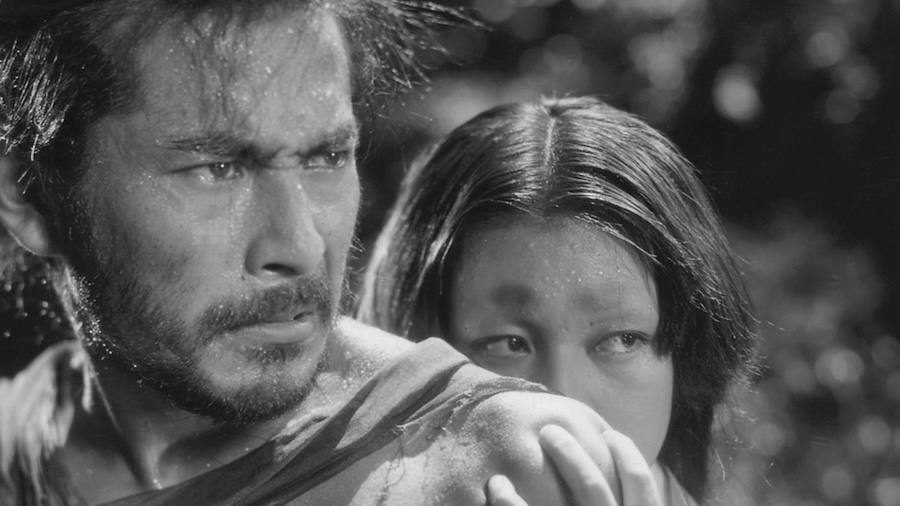
THE HUSBAND, THE WIFE… OR THE BANDIT?

The Rashomon effect is a term that entered the English language maybe as early as the 1960s, meant to describe an event that is interpreted in several different ways by spectators. The word ”Rashomon” is a Japanese name for a city gate, specifically the one in Kyoto that was built in the year 789. The name was much later used as the title of a short story by Ryunosuke Akutagawa, which inspired Akira Kurosawa’s film, even though the director was more influenced by ”In a Grove”, another short story by Akutagawa.
The fact that the title of the film became a part of the English language is a sign of how influential this masterpiece became. I first saw it in film class twenty years ago, and it’s still one of Kurosawa’s very best.
Three people by the city gate
On a rainy day, three people gather near the Rajomon city gate. Two of them, a woodcutter and a priest (Takashi Shimura, Minoru Chiaki) tell the third one (Kichijiro Ueda) that they have just witnessed something extraordinary. The woodcutter says that he found the body of a samurai (Masayuki Mori) who had been murdered in the forest. Along with the priest, who had seen the samurai and his wife (Machiko Kyo) earlier that day, he was summoned to testify at a hearing. There was also a bandit present, Tajomaru (Toshiro Mifune), who seemed insane, claiming that he had raped the wife and killed the samurai. However, when the wife was called to testify, her story didn’t add up with the bandit’s. Then, a medium was hired to contact the samurai from beyond the grave… and his story also differed from what the bandit and the wife were saying. What really happened?
Tension and curiosity builds
This was the movie that not only made Akira Kurosawa famous outside Japan’s borders, but also brought international attention to Japanese filmmaking as a whole. Kurosawa took a minimalist approach to the story and has later talked about how he wanted to get back to the visual imagination of silent films and use that as a way of expressing himself. Rashomon still relies heavily on dialogue obviously, even if each person’s account of what happened in the forest is illustrated.
Akira Kurosawa and cinematographer Kazuo Miyagawa create intense, intimate environs and Fumio Hayasaka’s music is a vital contribution.
Tension and our curiosity builds as we realize that the bandit, the samurai, the wife – and then ultimately the woodcutter – tells the story in a way that makes themselves come across in a better light. In the end, the truth no longer matters as much as the overall, multifaceted illustration of manipulation and human nature; one by one, each person’s ”truth” is destroyed and what we’re left with as a lasting theme is selfishness. Still, Kurosawa offers hope in the shape of a crying baby and parting clouds. The scenes at the city gate are dominated by heavy rain, while sunshine reaching through leaves is a key component of the scenes in the forest. Kurosawa and cinematographer Kazuo Miyagawa create intense, intimate environs and Fumio Hayasaka’s music is a vital contribution; the most memorable use of the score is a variation on ”Bolero” that brings out a lot of tension in the wife’s story.
One of the film’s superbly striking scenes is the medium’s séance with the dead samurai, where the woman speaks in a man’s garbled, ghostly voice while she moves around as if in an eerie dance, her clothes flapping in a mysterious strong wind.
The cast is noteworthy. Machiko Kyo in particular has a challenging role as the wife, brutally victimized in one of the testimonials, much more manipulative in other accounts; her role is the film’s most complex. As for Mifune, this wasn’t his first film with Kurosawa, but he certainly made an impact on international audiences, his portrait of a bandit who acts like a caged animal forever imprinted on moviegoers after this film.
Rashomon 1950-Japan. 88 min. B/W. Directed by Akira Kurosawa. Screenplay: Akira Kurosawa, Shinobu Hashimoto. Cinematography: Kazuo Miyagawa. Music: Fumio Hayasaka. Production Design: Takashi Matsuyama. Cast: Toshiro Mifune (Tajomaru), Machiko Kyo (The Samurai’s Wife), Masayuki Mori (The Samurai), Takashi Shimura, Minoru Chiaki, Kichijiro Ueda.
Trivia: Remade as Misty (1996) and in the U.S. as The Outrage (1964). The film received an honorary Oscar before the category of Foreign Language Film was created.
Venice: Golden Lion.
Last word: “When I took this project to Daiei, I told them the only sets I would need were the gate and the tribunal courtyard wall where all the survivors, participants and witnesses of the rape and murder that form the story of the film are questioned. Everything else, I promised them, would be shot on location. Based on this low-budget set estimate, Daiei happily took on the project. Later, Kawaguchi Matsutaro, at that time a Daiei executive, complained that they had really been fed a line. To be sure, only the gate set had to be built, but for the price of that one mammoth set they could have had over a hundred ordinary sets.” (Kurosawa, “Something Like an Autobiography”)
